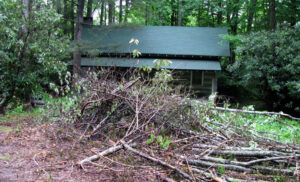Defensible Space requirements are added by SB 762. To reduce the spread of fire, vegetation must be modified to at least meet the standards of the International Wildland- Urban Interface Code. In Extreme Risk Areas a 100-foot radius from structures must have the vegetation modified. In the High Risk Areas, a 50-foot radius from structures must be modified. The standards for trees allow trees in the modification are providing the tree crowns are located at least 10 feet away from other tree crowns, structures, overhead power lines or other unmodified fuels. Deadwood and litter must be regularly removed. Tree crowns extending to within 10 feet of any structure shall be pruned to maintain a minimum horizontal distance of10 feet. Tree crowns within the defensible space shall be pruned to removed limbs less than 6 feet above ground surface adjacent to trees. Where ornamental vegetative fuels or cultivated grown cover, such as green grass, ivy, succulents or similar plants are used as ground cover, they are allowed to be within the defensible space, provided that they do not form a means of transmitting fire from the native growth to any structure.
Recent discussions with the State Fire Marshal disclose that they are working to develop an Oregon Code that would provide more flexibility than the International Code such as providing for clusters of trees and not just single trees. WE have expressed our concern about fire prone vegetation in riparian areas that cannot be removed without approval from the Oregon Department of Fish and Wildlife. The State Fire Marshal states that the emphasis of this whole program is for education of people residing in fire hazard areas. SB 762 does provide that there may be a graduated fee structure in assessing penalties for noncompliance. The Fire Marshal’s office has postponed the final adoption of Defensible Space Rules until after the Wildfire Risk Map is revised and adopted in a final form. This is scheduled to occur by the end of 2023. Many Counties already have a requirement for Defensible Space that is defined as a Fuel Break. Other jurisdictions have a Firewise Program that offers incentives to conform to Firewise standards that provide Defensible space. Once the new standards being developed by the Fire Marshal are adopted, the rules for fuel breaks will become mandatory in all jurisdictions. While we agree that the actions to modify vegetation can help to save structures during a fire event, we think that the program should be an incentive and educational program instead of a mandatory requirement on private property owners.

